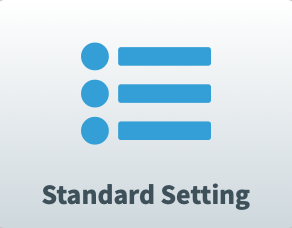About task types
The Tasks section of Surpass allows you to create, manage, and complete assignments. You can use tasks to create and review items and use the deadline tools to manage projects outside of the system.
There are four task types available in Surpass. This article describes the difference between Authoring tasks, Review tasks, Standard Setting tasks, and General tasks.
In this article
Authoring tasks

In an Authoring task, assignees write items and submit them for review.
To learn about Authoring tasks, read Creating an Authoring task, Working in an Authoring (Edit Existing Items) task as an assignee, Working in an Authoring (Create New Items) task as an assignee, Working in an Authoring (Edit Existing Items) task as a lead assignee, and Working in an Authoring (Create New Items) task as a lead assignee.
Review tasks

In a Review task, assignees inspect an item list on an item-by-item basis. Assignees may also be allowed to edit items in Review tasks. There are three editing modes available for Review tasks:
- In a Shared Review task, all assignees access and may edit the same version of a review item, with any changes visible to all assignees. For more information, read Creating a Review task, Working in a Shared Review task as an assignee, and Working in a Shared Review task as a lead assignee.
- In an Individual Review task, each assignee receives their own copy of a review item to edit. Their changes are private and visible only to the lead assignee. For more information, read Creating a Review task, Working in an Individual Review task as an assignee, and Working in an Individual Review task as a lead assignee.
- In an Item Analysis Review task, all assignees access and may comment on the same version of a review item, with any comments visible to all assignees. Lead assignees can make the final decision on items by either accepting, suggesting a change in answer or deleting the item. For more information, read Creating a Review task, Working in an Item Analysis Review tasks as an assignee and Working in an Item Analysis Review task as a lead assignee.
Standard Setting tasks

In a Standard Setting task, assignees rate items in an item list according to the Angoff rating method to help determine a cut score for your test. The Angoff rating method is designed to identify the proportion of minimally competent candidates.
To learn more about Standard Setting tasks, read Creating a Standard Setting task, Working in a Standard Setting task as an assignee, and Working in a Standard Setting task as a lead assignee.
General tasks

General tasks are useful for setting deadlines and prompting users to perform certain actions in Surpass.
To learn more about General tasks, read Creating a General task and Working in a General task as an assignee.
Further reading
To learn more about Tasks, read the following articles:
- Getting started in Tasks
- About the Tasks screen
- About item lists
- About task managers, assignees, and lead assignees
- Working as a task assignee
- Working as a lead assignee
- Working as a task manager
